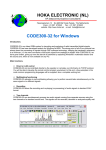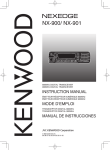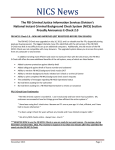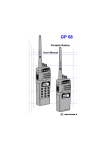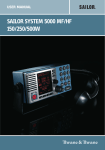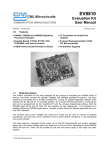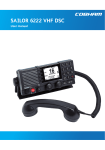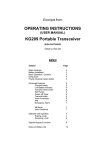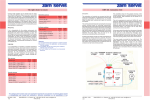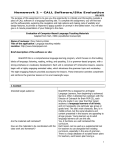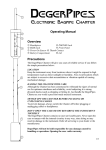Download SAILOR RT2048 VHF
Transcript
USER MANUAL SAILOR RT2048 VHF B2048GB-0a.indd i 23-08-2006 13:21:59 INTRODUCTION The SAILOR RT2048 VHF radiotelephone has been designed to comply with the increasing demands of a highly technological product, which means high quality, small size, etc. The SAILOR RT2048 has furthermore been designed to fit into the SAILOR Compact 2000 module programme. The SAILOR RT2048 can either be installed and operated as an independent unit, or in combination with other elements of the Compact 2000 programme. These include a duplex VHF radiotelephone, a coast telephony station with a 400W PEP SSB transmitter, and an SSB receiver with built-in FM and AM bands, and a scrambler which ensures complete communication secrecy. The SAILOR VHF RT2048 has, by means of the latest technology in casting technique, been constructed to withstand the most extreme conditions experienced in small, semi-open boats. Its compact, weatherproof construction ensures a degree of resistance to sea spray. The printed circuits inside have been designed with a high degree of compactness and exceptional performance. For more than half a century, SAILOR has been synonymous with state-of-the-art, high-quality maritime communications equipment - known for sturdiness, ease of operation and compact design. SAILOR is a world leader in the technologically advanced field of maritime communications. A wide range of products from GMDSS equipment, UAIS, and satellite communications equipment to simple VHF radios ensures the safety at sea and the daily communication around the world. In the design of this VHF RT2048 radiotelephone, SAILOR has taken into account all the circumstances it will be exposed to in day-to-day operation. However, even a product of this high quality requires regular servicing and maintenance, and we recommend a close observance of the directions contained in the instruction manual. Fast and professional service is one of our main concerns. SAILOR has a world-wide net of authorized distributors in more than 90 countries - and on top of that the SAILOR Certified Service Centre concept. In this way we are able to service you in the best way possible all over the world. B2048GB-0a.indd ii DISCLAIMER Any responsibility or liability for loss or damage in connection with the use of this product and the accompanying documentation is disclaimed by Thrane & Thrane. The information in this manual is provided for information purposes only, is subject to change without notice, may contain errors or inaccuracies, and represents no commitment whatsoever by Thrane & Thrane. This agreement is governed by the laws of Denmark. Manuals issued by Thrane & Thrane are periodically revised and updated. Anyone relying on this information should satisfy himself/herself as to the most current version. Providers with access to Thrane & Thrane’s Extranet may obtain current copies of manuals at: http://extranet.thrane.com. Thrane & Thrane is not responsible for the content or accuracy of any translations or reproductions, in whole or in part, of this manual from any other source. 23-08-2006 13:22:10 NOTE: 16 DISTRESS CALL PROCEDURE Transmit on channel 16: MAYDAY MAYDAY MAYDAY This is: NAME OF SHIP, call sign or other identification (THREE TIMES), followed by: MAYDAY - NAME OF SHIP Position, type of emergency, help required and other information which may help rescue operations. For clarity when SPELLING OUT words, the following alphabet should be used: A - Alfa N - November B - Bravo O - Oskar C - Charlie P - Papa D - Delta Q - Quebec E - Echo R - Romeo F - Foxtrot S - Sierra G - Golf T - Tango H - Hotel U - Uniform I - India V - Victor J - Juliett W - Whiskey K - Kilo X - X - ray L - Lima Y - Yankee M - Mike Z - Zulu PRIVATE CHANNELS There is standard provision for the programming of up to 10 private channels. However, it is possible to increase the total to 40 private channels if the scanning facilities are not required. 1. The distress call should be repeated from time-to-time until an answer is heard. 2. If no reply is heard on channel 16, the call should be repeated on any other available channel. 3. Speak slowly, pronouncing each word distinctly. A private channel is indicated with a prefix and a single digit. For the 10 standard channels the prefix is a “P”, if increased to 40 private channels the prefix will be “A”, “E” and “F”. SIMPLEX/SEMI-DUPLEX COMMUNICATION All the communication, that means ship/ship, ship/port, and ship/coast station, is carried out in the simplex or semi-duplex mode. This means that the handset key switch is depressed while the message is delivered, ending with the word "over". The switch is now released, allowing the other party to reply. OPERATING The operating panel is provided with a really high quality pushbutton keyboard, offering an attractive solid feel. Furthermore, keyed operations are instantly confirmed by means of the display read-out. To ensure safe operation under all conditions, the keyboard is fitted with night-time illumination. Private channels include fishing and leisure channels as well as the special channels allocated by post and telegraph authorities. CONTROLS VOL SCAN DELETE Indication of ON/OFF/VOL turn-style knob operation. OFF SCAN TIME Deletes a channel from the scanning table. Selects the scan time from 1 to 99 seconds. The time chosen will be used to listen on one of the secondary channels receiving a signal. D.W. SQ Selects the dual watch facility. Squelch sensitivity control knob with turn-style operation. 1W 16 Quick select of the call and distress channel 16. Selects 1W reduced power output. U.S. 1 Digits from 1 to 0. Selects the VHF channels used in the USA. DIM SHIFT Activates the functions marked in orange on the keyboard. Whenever the keyboard is in “shift-mode” it will be indicated by “cornerbars” in the display. SELCALL T/ R 1w SCAN US Tests the selcall decoder and resets the selcall decoder after a call. P Selects scanning programme. SCAN ADD Tx The intensity of the LED-indicators can be controlled in four steps. The keyboard illumination is switched on and off. Adds a channel to the scanning table. Selects the standard private channels. READ-OUT • CHANNEL READ-OUT All international maritime channels are shown by the two digits, when the channel has been keyed in. Selection of a standard private channel will be indicated with a P-. 1W POWER •InREDUCED harbour areas, or in the close vicinity of another vessel, transmissions should be with reduced power. When the display shows 1W, the transmitter power output is reduced from 25W to 1W. Where two stations are close together, this reduction can improve communication quality. Tx US • TRANSMITTING Whenever the handset switch is depressed, and the transmitter output power level has reached an appropriate level, the "TX" will appear. If the transmitter time-out timer is enabled, and an automatic termination of a transmission has occurred, this indicator will be flashing. • US-CHANNELS In the USA a number of the international duplex channels are used as simplex channels. Ships sailing in American waters must, therefore, be able to select these channels as simplex channels. The appearance of "US" on the display indicates that this mode of operation is in use. OPERATION The VHF radiotelephone is operated by means of two turn-style knobs and a push-button keyboard. This combination ensures a high continuous resolution on squelch and AF-level, and an easy selection of channels etc in all situations. How to Return to 25W Output Power How to Return to International Channels Press: Press: 1W The highly efficient LED-display shows the operating channel both under normal use and in dual watch mode. The display also indicates when the set is scanning or a call has been detected by the selcall decoder. The functions 1W, TX, and US are indicated by means of LED-illumination. U.S. SHIFT SHIFT Read-out: Read-out: When the station is switched off, the necessary settings will be stored in the built-in-memory, and as soon as the station is switched on again, it will start up on the same channel etc. How to Select the Distress and Call Channel 16 How to Select a Private Channel Press: E.g. channel P3. Press: 1W P SHIFT 16 3 Read-out: Read-out: Tx 1W US Tx US How to Select Channels Used in the USA How to Change Display Light Intensity Press: Press: DIM U.S. SHIFT SHIFT Read-Out For single step change or 1W Tx US 1W Tx DIM US SHIFT and keep How to Select a Channel E.g. channel 23. Press: How to Select Reduced Output Power 3 Tx US How to Raise Output Power to 25W on Channels 13 or 67 in US-Mode Press: 2 1W 1W SHIFT Press: Read-out: Read-out: SHIFT and keep 1W depressed simultaneously with the handset key. 1W Tx US 1W Tx US Read-out: 1W Tx US depressed for multiple step change. Totally 4 steps in the cycle. In the step before extinction, the keyboard will be illuminated. SELECTIVE CALLING DUAL WATCH OPERATION (If built-in) When a selective call is received from a coast station, the read-out will alternatively show CA, and the actual selected channel and the acoustic alarm will sound for 10 seconds. When an "all ships call" containing distress messages, gale warnings, navigational warnings, etc, is received from a coast station, the readout will alternatively show C0, and the actual selected channel and the acoustic alarm will sound until the selcall is reset. In addition to the selected channel, which is shown on the display, the VHF station will listen on channel 16 for 0.1 second every 1.2 second. If there is a signal on channel 11, the dual watch sequence will be as follows: Any signal received on channel 16 will be heard continuously and the readout will show "16" until the signal ceases. If the transmitter is keyed, the dual watch function will be switched off and the read-out will show the channel selected. How to Test the Selcall Decoder Press: SHIFT How to Select Dual Watch SELCALL T/ R Press: D.W. The read-out will alternate between: SHIFT Read-out: and 1W Tx US 1W Tx The acoustic alarm will sound. This read-out indicates that the test has been correctly carried out. and US 1W Tx US alternatively. Now press: SHIFT SELCALL T/ R to reset the selcall decoder. How to Switch Off Dual Watch Press: D.W. SHIFT How to Reset the Selcall Decoder Read-out: After an individual call or an "all ships call" has been received, press: SHIFT SELCALL T/ R 1W Tx US 1W Tx US SCANNING OPERATION (If scanning is enabled) The VHF radiotelephone is provided with a flexible scanning facility. The scanning programme is fully user programmable, and can include all the international channels and the ten private channels PO -P 9. When a scanning programme is created by the operator, the programme will be stored in a memory which retains the scanning programme even when the station is switched off. The scanning programme can be changed during operation by pressing "ADD" or "DELETE". SCANNING How to Return to the Last Channel with Signal How to Delete a Channel from the Scanning Programme Press: E.g. to delete channel 69, press: SCAN SCAN DELETE SHIFT 6 9 SHIFT The read-out shows the next channel in the programme, e.g.: How to Check the Channels Contained in the Scanning Programme In principle, scanning is an advanced form of the dual watch system in which the secondary channel selected changes constantly whilst the distress and Press: call channel 16 is listened to simultaneously SCAN If, for example, a scanning programme consists of channels 6, 11, 17, and 70, SHIFT and a long press on the scanning sequence will look like this: and the channels in the programme will slowly be shown in the display. 1W Tx US The revised scanning programme becomes operative by pressing: SCAN SHIFT If there is a signal on channel 11, the sequence will be: Read-out: How to Add a Channel SCAN to the Scanning Programme TIME »Scan Time« E.g. to add channel 69, press: The "Scan Time" is the time during which the scanner listens on channel 11 whilst at the same time watching out on channel 16 - exactly as it happens on the dual watch system. The "Scan Time" can be programmed by the operator To obtain a continuous listening to the signal being received on channel 11, the scanning is stopped by simply pressing "SHIFT" "SCAN". SCAN ADD 6 9 SHIFT Read-out: How to Stop the Scanner Press: Press any of the buttons: SCAN TIME 1W 0 Read-out: Tx US To restart the scanning programme, press: SCAN 9 or US Press: SCAN SHIFT Tx How to Read the Programmed "Scan Time" The scanning can be started again by pressing "SHIFT" "SCAN". How to Start the Scanner 1W 16 Read-out e.g.: SHIFT and the actual "Scan Time" will be read out in the next 2.5 seconds, e. g. scan time = 5 seconds: SHIFT Read-out: 1W Tx US followed by the selected channel. 1W Tx US 1W Tx US The channel number corresponding to the activated push-button. 1W Tx US How to Programme/Change the "Scan Time" To set the "Scan Time" to 10 seconds press: SCAN TIME SHIFT SCAN TIME 1 0 Note! After "SHIFT" "Scan Time" has been keyed in. The maximum time between the following entries must be 2.5 seconds, or the input sequence will be ignored. The read-out will be the entered digits, followed by the selected channel after a period of 2.5 seconds. Empty Scanning Programme If the scanning programme is empty, or attempt has been made to add a new channel to a »full« scanning programme (which means that the existing programme includes the maximum number of channels permitted), the read-out will show: 1W Tx US for a period of 2.5 seconds, followed by the selected channel. SHIFT 1 2 3 4 5 6 7 8 9 10 11 12 13 14 15 16 17 18 19 20 21 22 23 24 25 26 27 28 P P P P P SIMPLEX • • • • • • • • • • • • • • • DUPLEX • • • • • • • • • • • • Distress and Calling • • • • • • • • • • • Tx: 156.050 MHz Rx: 160.650 MHz Tx: 156.100 MHz Rx: 160.700 MHz Tx: 156.150 MHz Rx: 160.750 MHz Tx: 156.200 MHz Rx: 160.800 MHz Tx: 156.250 MHz Rx: 160.850 MHz Tx: 156.300 MHz Rx: 156.300 MHz Tx: 156.350 MHz Rx: 160.950 MHz Tx: 156.400 MHz Rx: 156.400 MHz Tx: 156.450 MHz Rx: 156.450 MHz Tx: 156.500 MHz Rx: 156.500 MHz Tx: 156.550 MHz Rx: 156.550 MHz Tx: 156.600 MHz Rx: 156.600 MHz Tx: 156 650 MHz Rx: 156.650 MHz Tx: 156.700 MHz Rx: 156.700 MHz Tx: 156.750 MHz Rx: 156.750 MHz Tx: 156.800 MHz Rx: 156 800 MHz Tx: 156.850 MHz Rx: 156.850 MHz Tx: 156.900 MHz Rx: 161.500 MHz Tx: 156.950 MHz Rx: 161.550 MHz Tx: 157.000 MHz Rx: 161.600 MHz Tx: 157.050 MHz Rx: 161.650 MHz Tx: 157.100 MHz Rx: 161.700 MHz Tx: 157.150 MHz Rx: 161.750 MHz Tx: 157.200 MHz Rx: 161.800 MHz Tx: 157.250 MHz Rx: 161.850 MHz Tx: 157.300 MHz Rx: 161.900 MHz Tx: 157.350 MHz Rx: 161.950 MHz Tx: 157.400 MHz Rx: 162.000 MHz FREQUENCIES Tx: 156.050 MHz Rx: 160.650 MHz Tx: 156.100 MHz Rx: 160.700 MHz Tx: 156.150 MHz Rx: 160.750 MHz Tx: 156.200 MHz Rx: 160.800 MHz Tx: 156.250 MHz Rx: 160.850 MHz Tx: 156.300 MHz Rx: 156.300 MHz Tx: 156.350 MHz Rx: 156.350 MHz Tx: 156.400 MHz Rx: 156.400 MHz Tx: 156.450 MHz Rx: 156.450 MHz Tx: 156.500 MHz Rx: 156.500 MHz Tx: 156.550 MHz Rx: 156.550 MHz Tx: 156.600 MHz Rx: 156.600 MHz Tx: 156 650 MHz Rx: 156.650 MHz Tx: 156.700 MHz Rx: 156.700 MHz Tx: 156.750 MHz Rx: 156.750 MHz Tx: 156.800 MHz Rx: 156 800 MHz Tx: 156.850 MHz Rx: 156.850 MHz Tx: 156.900 MHz Rx: 156.900 MHz Tx: 156.950 MHz Rx: 156.950 MHz Tx: 157.000 MHz Rx: 161.600 MHz Tx: 157.050 MHz Rx: 157.050 MHz Tx: 157.100 MHz Rx: 157.100 MHz Tx: 157.150 MHz Rx: 157.150 MHz Tx: 157.200 MHz Rx: 161.800 MHz Tx: 157.250 MHz Rx: 161.850 MHz Tx: 157.300 MHz Rx: 161.900 MHz Tx: 157.350 MHz Rx: 161.950 MHz Tx: 157.400 MHz Rx: 162.000 MHz 60 61 62 63 64 65 66 67 68 69 70 71 72 73 74 75 76 77 78 79 80 81 82 83 84 85 86 87 88 P P P P SIMPLEX • • DSC • • • • • •• IC BL RT • • • • • • • • • • • • • • • • • • • • • • • • • • • • • • • • • U PU PO DUPLEX SA U -SI SA M -D PL U EX PL C EX H A C NN H AN EL N S EL S IP PO RT SH S EL N TE R IN AN H C SA SA SIM -D PL U EX PL EX CH C AN H N AN E N LS EL S U FREQUENCIES U IC BL RT PU PO PO RT SH TE R IN C H AN N EL S IP CHANNEL APPLICATION AND FREQUENCY TABLE FREQUENCIES Tx: 156.025 MHz Rx: 160.625 MHz Tx: 156.075 MHz Rx: 160.675 MHz Tx: 156.125 MHz Rx: 160.725 MHz Tx: 156.175 MHz Rx: 160.775 MHz Tx: 156.225 MHz Rx: 160.825 MHz Tx: 156.275 MHz Rx: 160.875 MHz Tx: 156.325 MHz Rx: 160.925 MHz Tx: 156.375 MHz Rx: 156.375 MHz Tx: 156.425 MHz Rx: 156.425 MHz Tx: 156.475 MHz Rx: 156.475 MHz Tx: 156.525 MHz Rx: 156.525 MHz Tx: 156.575 MHz Rx: 156.575 MHz Tx: 156.625 MHz Rx: 156.625 MHz Tx: 156.675 MHz Rx: 156.675 MHz Tx: 156.725 MHz Rx: 156.725 MHz Tx: 156.775 MHz Rx: 156 775 MHz Tx: 156.825 MHz Rx: 156.825 MHz Tx: 156.875 MHz Rx: 156.875 MHz Tx: 156.925 MHz Rx: 161.525 MHz Tx: 156.975 MHz Rx: 161.575 MHz Tx: 157.025 MHz Rx: 161.625 MHz Tx: 157.075 MHz Rx: 161.675 MHz Tx: 157.125 MHz Rx: 161.725 MHz Tx: 157.175 MHz Rx: 161.775 MHz Tx: 157.225 MHz Rx: 161.825 MHz Tx: 157.275 MHz Rx: 161.875 MHz Tx: 157.325 MHz Rx: 161.925 MHz Tx: 157.375 MHz Rx: 157.375 MHz Tx: 157.425 MHz Rx: 157.425 MHz FREQUENCIES Tx: 156.025 MHz Rx: 160.625 MHz Tx: 156.075 MHz Rx: 160.675 MHz Tx: 156.125 MHz Rx: 160.725 MHz Tx: 156.175 MHz Rx: 156.775 MHz Tx: 156.225 MHz Rx: 160.825 MHz Tx: 156.275 MHz Rx: 156.275 MHz Tx: 156.325 MHz Rx: 156.325 MHz Tx: 156.375 MHz Rx: 156.375 MHz Tx: 156.425 MHz Rx: 156.425 MHz Tx: 156.475 MHz Rx: 156.475 MHz Tx: 156.525 MHz Rx: 156.525 MHz Tx: 156.575 MHz Rx: 156.575 MHz Tx: 156.625 MHz Rx: 156.625 MHz Tx: 156.675 MHz Rx: 156.675 MHz Tx: 156.725 MHz Rx: 156.725 MHz Tx: 156.775 MHz Rx: 156 775 MHz Tx: 156.825 MHz Rx: 156.825 MHz Tx: 156.875 MHz Rx: 156.875 MHz Tx: 156.925 MHz Rx: 156.925 MHz Tx: 156.975 MHz Rx: 156.975 MHz Tx: 157.025 MHz Rx: 157.025 MHz Tx: 157.075 MHz Rx: 157.075 MHz Tx: 157.125 MHz Rx: 157.125 MHz Tx: 157.175 MHz Rx: 157.175 MHz Tx: 157.225 MHz Rx: 161.825 MHz Tx: 157.275 MHz Rx: 161.875 MHz Tx: 157.325 MHz Rx: 161.925 MHz Tx: 157.375 MHz Rx: 157.375 MHz Tx: 157.425 MHz Rx: 157.425 MHz 0548 QUICK SELECT CHART Distress and Call Channel Channel Selection 16 1 3 U.S. US-mode (Channel Required in the USA) SHIFT Reduced Power SHIFT Dual Watch SHIFT Start Scanning SHIFT 1W D.W. SCAN Add a Channel to Scanning Programme 2 3 SHIFT Delete a Channel from Scanning Programme 2 3 SHIFT Set of ”Scan Time” to 10 Seconds B2048GB-0a.indd iii SHIFT SCAN TIME 1 SCAN ADD SCAN DELETE 0 SHIFT SCAN TIME 23-08-2006 13:22:10 B2048GB Issue: C/0548 Thrane & Thrane A/S B2048GB-0a.indd iv • [email protected] • www.thrane.com 23-08-2006 13:22:10













